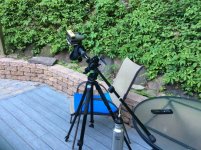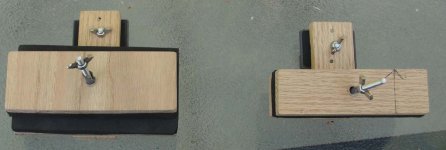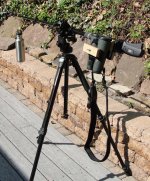...the cardinal point that still does not seem well defined and focused is this:
someone thinks and believes (sometimes or often without having ever tried it), that a 25x provides less detail, in proportion to a 7x...
I think there is plenty of agreement that it is possible for 25x to show more detail than 7x in hand-held viewing. We just don't agree that it is a good overall choice for hand-held viewing.
...we should not defend a compromise choice that was considered by the military more than 70 years ago, even if this could prove useful (and I doubt it) to someone for the action of the birder on every occasion...
Many birders already agree that the "military" ideal compromise for handheld magnification of 7x is not accurate as a practical limit for birding. We tend to think more towards 10x (but certainly not 12x or 15x or 25x!). Even so, we often still choose 7x or 8x for advantages of FOV and DOF.
...But this is not the purpose of this discussion, since as I have already said, the discussion must be valid in general, and should evaluate (at least initially) the fundamental theoretical bases on which to build a new functional idea (for different events)...
I think that many of us are open to the idea of considering different magnifications and viewing techniques for different purposes.
...I am not a birder and I could not be even if I wanted to, because in my area I would be able to identify perhaps only 40 different species of birds (on average 10-20 in a day). Despite this, I happily use binoculars to observe the local fauna as well, which for natural reasons does not come easily...
I understand that birding, exclusively, might not be satisfying if you live in an area with very low species diversity. Around here, it is possible to find over 200 species in a day in spring, and in winter we hope for over 75 species on a good day. Still, I have many other interests besides birding.
...So, I ask myself: how many of us can say that we normally observed Terns and Bee-eaters, when hunting for food, at distances of 10-15m? It seems logical to me that for these events (and many others) more magnifications will be needed compared to 6x. I like it and I can also observe nature for dozens of continuous minutes freehand with the 25x (not only for 2-3 sec), satisfactorily. The important thing is that if I want to observe the more stable fauna (or the moon), I can do it in the most peaceful calm of resting the 25x on something solid and thus enjoying more details, but much more enlarged and detailed than a 6x or of an 8x...
As a point of fact, please know that in the course of birding, even small birds are routinely detected and identified at distances well beyond 10-15 m. I think 75 m is perhaps a more realistic measure of the typical limit for the high-comfort zone for detection and identification of most small birds in a familiar setting. Bee eaters are medium sized birds and terns are large.
That point aside, I'm sure many of us agree that higher magnifications are often useful for natural history pursuits. That's why we often own and use scopes on tripods. Believe me, we'd love it to be true that we could use 25x scopes or binoculars handheld. We'd love not to have to haul that tripod. And our conviction that we can't hand hold 25x is not a result of being brainwashed by the 7x military paradigm. Rather, it is based on our own practical experience. We've tried to hand hold 25x and found that we failed. I know that I have! My Nikon 27x50ED Fieldscope with Velbon 455 Ultra tripod and RRS bh-25 head is extraordinarily compact and lightweight for travel, but if I could get away with leaving the tripod behind, I would! For daily birding, I have little trouble managing an ~80 mm scope on a sleek but robust CF tripod with good fluid head, so I'm not much tempted to go lighter by hand-holding a conventional optic or by carrying along high power IS binoculars in addition to my 8x standard bins.
So if you really want to move the discussion forward and convince us of the feasibility of a
...a new functional idea (for different events)...
, you are going to have to explain more about how it is that you are able to use 25x for extended comfortable hand-held observation. If you don't tell us more, and if you don't tell us something new and surprising that we can do ourselves, we are going to conclude that we've already been where you are (i.e. that we've already tried what you are doing) and have found the quality of viewing unsatisfactory by our standards, or that you have superhuman abilities that we cannot employ. For example, consider Steve C's reaction:
...One of the problems inherent in Rico's posts is the stated idea he can freehand high magnification binoculars. Lots of people, including me, are understandably perplexed by this. I dug out a 20x60 Pentax porro, the largest magnification binocular I have. I most assuredly am unable to use it in the manner I think Rico is saying...
So Rico70, again, if you want to get traction with your argument, you've got to tell us more. We want to believe what you are saying, but just hoping that what you are saying is true has not been sufficient for us to find the promised land. Some, like Troubador, have already (in the past) tried a leap of faith
The largest magnification bino I have is a Conquest 15x56 and very early in my time with it, in a fit of enthusiasm, I took it as my only bino on trip ...and my performance those days with the 15x was lamentable...
and still didn't find the heavenly paradise you describe for yourself and (in past posts) for naive users who haven't been corrupted by the nothing-higher-than-7x dogma (or blasphemy, depending on your perspective).
I think you've got to tell us more if any of us are to follow this discussion any further with any real interest.
--AP







